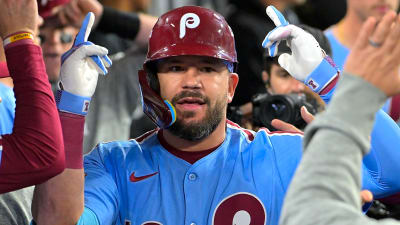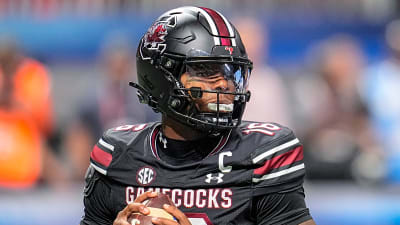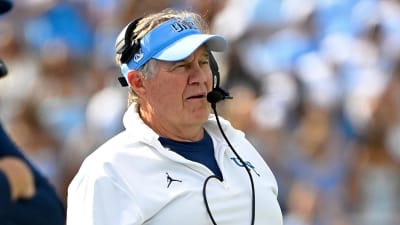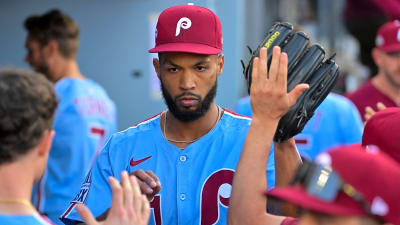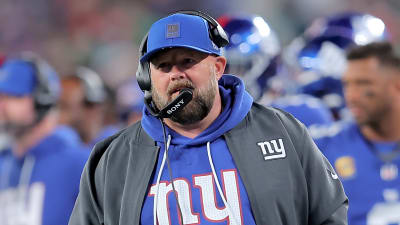
These last few months have been a complete whirlwind for the Toronto Blue Jays and superstar first baseman Vladimir Guerrero Jr.
The future of this franchise looked incredibly bleak after Guerrero’s Feb. 18 negotiations deadline came and went without the announcement of a long-term deal, making it seem like he was destined to enter free agency next off-season. But now, less than two months later, even after all the interviews and reported leaks regarding his contract demands surfaced, we’ve arrived at a resolution.
Everything changed late Sunday night, as the 26-year-old reportedly agreed to a historic 14-year, $500-million contract extension that’ll begin next season and run through 2039. While the deal is pending a physical, it’ll become the richest in franchise history once finalized, blowing past George Springer’s six-year, $150-million contract.
Vladimir Guerrero Jr. and the Blue Jays have reached agreement on a $500-million, 14-yr extension that’s pending a physical, according to an industry source.
There is no deferred money in the looming deal, making it the second richest contract in terms of present value in MLB.
— Shi Davidi (@ShiDavidi) April 7, 2025
You’re probably thinking, “Committing half a billion dollars over 14 years is quite the investment for just one player, particularly a first baseman.” And, well, you wouldn’t be wrong to come to that conclusion. Even for professional athletes, that’s a ton of money. For the Blue Jays, they’ve allocated those resources to the least valuable position on the diamond.
However, Guerrero’s franchise-altering extension — which will become the second-largest contract in present-day value, ahead of Shohei Ohtani’s heavily deferred deal (valued at approximately $460 million) and behind only Juan Soto’s defer-less $765-million mega contract — signifies more than simply ensuring he’ll remain a lifelong Blue Jay.
By extending the four-time All-Star, Toronto’s front office is (finally) committing to a direction as a franchise, announcing to the baseball world their plans of contending beyond the 2025 campaign. Of course, that was a huge question mark hanging over this organization due to the pending free agencies of their two franchise cornerstones — Guerrero and Bo Bichette.
With the first of those two soon-to-be officially extended, the circumstances surrounding this team’s competitive window and its previous grim outlook have been dramatically altered — in both the short and long term.
Let’s start with how Guerrero’s extension will impact management’s plans for this season. Previously, general manager Ross Atkins could’ve easily hit the reset button on this roster leading up to the July 31 trade deadline if they fell out of playoff contention by June — just as they did last season. This time around, though, missing the post-season would likely trigger a full-scale rebuild centred around the organization’s most coveted top-tier items.
Granted, Atkins could still follow through on a lower-scale sell-off even after locking up Guerrero, considering Bichette, Chris Bassitt, Max Scherzer, Chad Green, and Erik Swanson are all free agents after ’25, followed by the likes of Springer, Kevin Gausman, Daulton Varsho and Yimi García hitting the open market during the ensuing off-season. But the chances of moving all those pieces are undoubtedly much lower now.
The verdict is still out on whether the Blue Jays, as currently constructed, feature enough talent to return to the playoffs this fall after winning just 74 games a season ago. Still, the likelier outcome if they ultimately became sellers would probably include fielding offers on non-core players — mirroring last season’s deadline approach — rather than choosing a more invasive path.
Simply put, Toronto isn’t entering a rebuild after spending $500 million on the face of the franchise, and rightly so. They’re looking to build around him. And to do that, they’ll need to continue to develop and acquire talent, not trade it away.
This brings us to the macro-level impact of Guerrero’s extension. The Blue Jays have drawn a line in the sand with this deal. They’re no longer flirting with hopes of spending like a big-market club. They’re now operating as a big-market spender, putting them in the same conversation as the Los Angeles Dodgers, Philadelphia Phillies, New York Mets and Yankees.
And quite frankly, that’s precisely where this franchise — owned by Rogers Communications — should be positioned. They entered this season with the fifth-highest Competitive Balance Tax (CBT) payroll in the sport at a projected $251 million, according to FanGraphs’ Roster Resource, and already feature roughly $182 million in salary guarantees for next season — the third-most behind only the Mets ($203 million) and Dodgers ($299 million).
That’s before including a potential extension for Bichette.
Regarding future spending, since the Blue Jays have yet to officially announce Guerrero’s extension, which carries an average annual value of approximately $35.7 million, it’s unclear how the front office plans to structure it financially. However, even if it’s a straightforward breakdown, they’d only be looking at a year-to-year increase of just over $7 million from his ’25 salary of $28.5 million.
For luxury tax purposes, such an increase would still leave Toronto’s projected CBT payroll for next season at a few hundred thousand below $200 million, placing them roughly $44 million below the initial luxury-tax threshold — with each tier increasing by $20 million.
So, there’s no more dancing around whether or not this team can flex its financial muscles. Time after time, example after example, they’ve shown a history of doing just that, albeit when the right opportunity arises — with Guerrero’s deal being the latest one.
Cementing that status indicates ownership’s continued commitment to spending towards building a winning product. If you’re Bichette, who’s publicly stated several times that he desires to win a World Series in Toronto alongside Guerrero, that’s exactly what you want to see. Likewise for Varsho, considering he’s another critical piece of this team’s core that management hopes to extend long-term.
Suddenly, we’re now starting to see the makings of a new core emerging for the Blue Jays, one they’ll hope to build around moving forward. As many players as they have scheduled to hit free agency over the next few seasons, they also have five signed through 2028 — Andrés Giménez, José Berríos (opt-out after ’26), Anthony Santander (opt-out after ’27), Alejandro Kirk and now Guerrero.
It’s a group that’ll look even stronger if management can work out long-term extensions for Bichette and Varsho. While that’ll include an extensive process, particularly involving the club’s All-Star shortstop, the odds of both coming to fruition have undoubtedly increased with Guerrero’s deal in place.
From a position-player standpoint, that’s a pretty impressive core to move forward with. Between Giménez, Kirk and Varsho, those three combined for 31.8 fWAR from 2022-24. If you add Bichette’s career WAR of 16.5 and Guerrero’s of 17.0, your squad possesses quite a formidable foundation.
Not only that, but it also figures to solve one of the biggest issues this team encountered while attempting to recruit free agents last off-season — becoming a desirable free-agent destination. Extending Guerrero won’t address that concern entirely, at least probably not as much as a deep playoff run this fall would, but having any questions regarding his future put to rest should serve as a substantial advantage — as would extending Bichette before free agency opens next off-season.
At which point, based on recent history, Toronto’s front office will be expected to operate aggressively. That’s the standard they’ve set between chasing Ohtani and Soto, among several other marquee players, and agreeing to such a lucrative figure with Guerrero. Everyone knows they have money to spend, and this recent mega-deal further proves that.
So, when the time comes to search for starting pitching upgrades six-plus months from now, with Bassitt and Scherzer both becoming free agents, chances are there’ll be numerous reports linking them with the top arms on the market — slated to include Dylan Cease, Framber Valdez and Zac Gallen.
Whether or not the Blue Jays come away with one of those front-line starters is another question altogether. Given their need for high-upside pitchers, though, money shouldn’t be the sole reason their starting rotation fails to repeat as one of their biggest strengths in ’26.
The Guerrero extension has saved this franchise’s competitive window from falling off a cliff after this season. That window was preparing to slam shut with both of the club’s franchise cornerstones unsigned beyond ’25. Now, with one-half of that superstar duo inked through the next decade and a half, the window has been kicked wide open again.
There’s renewed positivity surrounding this team, a feeling that somewhat resembles the hope that followed the ’21 version of the roster that was supposed to lead the franchise to a new age of playoff success. While that has yet to occur, perhaps this new emerging core will lead the organization to its first post-season win since ’16.
More must-reads:
- Ranking four potential World Series matchups based on excitement level
- Five MLB stars who need to step it up in the postseason
- The 'MLB playoff debut strikeouts leaders' quiz
Breaking News
Trending News
Customize Your Newsletter
 +
+
Get the latest news and rumors, customized to your favorite sports and teams. Emailed daily. Always free!
